Ad
Tìm hiểu và triển khai ứng dụng Web với Kubernetes
- 1. Kubernetes trong triển khai ứng dụng web PhongNX
- 2. Agenda Bối cảnh Nhắc lại về Docker Giới thiệu Kubernetes Kiến trúc Kubernetes Các thành phần cơ bản trong Kubernetes Rancher 2.0 Harbor – Docker registry Demo
- 3. Agenda Bối cảnh Nhắc lại về Docker Giới thiệu Kubernetes Kiến trúc Kubernetes Các thành phần cơ bản trong Kubernetes Rancher 2.0 Harbor – Docker registry Demo
- 4. Docker xuất hiện mở ra cuộc cách mạng về ảo hoá
- 5. Các vấn đề liên quan đến triển khai hệ thống Health Discovery Scheduling Configuration Scaling Security There are more! Monitoring
- 8. Agenda Bối cảnh Nhắc lại về Docker Giới thiệu Kubernetes Kiến trúc Kubernetes Các thành phần cơ bản trong Kubernetes Rancher 2.0 Harbor – Docker registry Demo
- 9. Vấn đề trong triển khai hệ thống phần mềm
- 10. m n
- 11. Giải pháp triển khai hệ thống phần mềm
- 13. So sánh với các HyperVisor
- 14. HyperVisor Type 2 Docker Virtualization Type Vitualization Machine Container Weight of the created virtual systems Heavy Very lightweight Startup time for created machine A few minutes A few seconds Isolation level for created vitural systems Full Partial Guaranteed Resources at Hardware Level ? Yes No Can create machines with different OS ? Yes No
- 15. Kiến trúc Docker
- 16. Nginx Php - fpm Mysql Docker Container Simple web app
- 17. Agenda Bối cảnh Nhắc lại về Docker Giới thiệu Kubernetes Kiến trúc Kubernetes Các thành phần cơ bản trong Kubernetes Rancher 2.0 Harbor – Docker registry Demo
- 19. κυβερνήτης
- 20. k8s
- 21. Kubernetes Manage application, not machine Kubernetes là một Platform tự động hoá việc quản lý, scaling container Kubernetes còn gọi là Container orchestration engine. Kubernetes by Google dựa trên kinh nghiệm quản lý sử dụng các container
- 22. =
- 23. Kubernetes vs Docker Swarm https://platform9.com/blog/kubernetes-docker-swarm-compared/
- 24. Kubernetes làm được những gì Việc quản lý hàng loạt docket host Container Scheduling Rolling update Scaling/Auto Scaling Monitor vòng đời và tình trạng sống chết của container. Self-healing trong trường hợp có lỗi xãy ra. (Có khả năng phát hiện và tự correct lỗi) Service discovery Load balancing Quản lý data Quản lý work node Quản lý log Infrastructure as Code Sự liên kết và mở rộng với các hệ thống khác
- 25. Kubernetes liên kết với hệ sinh thái Ansible: Deploy container tới Kubernetes Apache Ignite: Sử dụng Service Discovery của Kubernetes, tự động tạo và scaling k8s clkuster Fluentd: gửi log của container trong Kubernetes Jenkins: Deploy container đến Kubernetes OpenStack:Cấu trúc k8s liên kết với Cloud Prometheus: Monitor Kubernetes Spark: Thực thi native job trên Kubernetes(thay thế cho YARN) Spinnaker:Deploy container đến Kubernetes v.v
- 26. Các môi trường Kubernetes Local Kubermetes Công cụ hỗ trợ thiết lập môi trường Kubernetes Quản lý Kubernetes trên public cloud
- 28. Công cụ hỗ trợ thiết lập môi trường Kubernetes kubeadm Rancher
- 29. Quản lý Kubernetes trên public cloud Google Kubernetes Engine(GKE) Azure Container Service(AKS) Elastic Container Service for Kubernetes(EKS) GKE AKS
- 31. Agenda Bối cảnh Nhắc lại về Docker Giới thiệu Kubernetes Kiến trúc Kubernetes Các thành phần cơ bản trong Kubernetes Rancher 2.0 Harbor – Docker registry Demo
- 36. Agenda Bối cảnh Nhắc lại về Docker Giới thiệu Kubernetes Kiến trúc Kubernetes Các thành phần cơ bản trong Kubernetes Rancher 2.0 Harbor – Docker registry Demo
- 37. Node
- 41. Node Node Node Master API Scheduler etc.. kubelet kubelet kubelet
- 42. Kubernetes Resource Phân Loại Resource Mô tả Workloads Resource liên quan đến thực thi container Discovery&Load balancer Resource cung cấp Endpoint - cho phép truy cập Container từ bên ngoài Cluster Config&Storage Resources liên quan đến settings, confidential information, persistent volumes vv Cluster Resources liên quan đến security và quota Metadata Resource cho việc quản lý Resource
- 43. Workloads Pod ReplicationController ReplicaSet Deployment DaemonSet StatefulSet Job CronJob Discovery&LB resource Service ClusterIP NodePort LoadBalancer ExternalIP ExternalName Headless Ingress Config&Storage Secret ConfigMap PersistentVolumeClaim Cluster resource Namespace ServiceAccount Role ClusterRole RoleBinding ClusterRoleBinding NetworkPolicy ResourceQuota PersistentVolume Node Metadata resource CustomResourceDefinition LimitRange HorizontalPodAutoscaler
- 44. Workloads Pod ReplicationController ReplicaSet Deployment DaemonSet StatefulSet Job CronJob Discovery&LB resource Service ClusterIP NodePort LoadBalancer ExternalIP ExternalName Headless Ingress Config&Storage Secret ConfigMap PersistentVolumeClaim Cluster resource Namespace ServiceAccount Role ClusterRole RoleBinding ClusterRoleBinding NetworkPolicy ResourceQuota PersistentVolume Node Metadata resource CustomResourceDefinition LimitRange HorizontalPodAutoscaler Application Developer normally use 3 types
- 46. Pod
- 47. Basic unit of deployment in k8s
- 50. Shared storage
- 54. Guaranteed to be on the same node
- 55. container container container container container container container container container Node Node Node Pod Pod Pod
- 56. container container container container container container Node Node Node Pod Pod container container container Pod container container container Pod container container container Pod container container container Pod container container container Pod Depends on each node’s resource availability and each pod’s resource requirement
- 58. container container container Node Node This will NEVER happen
- 59. MasterAPI UI CLI Node 1 Node 2 Node 3 Pod
- 60. Pod Node MasterAPI UI CLI Node 1 Node 2 Node 3 Pod =
- 61. Demo Pod
- 62. ReplicaSet
- 63. Keep track of Pod replicas
- 64. Replica Set container container container Pod replica: 3 template: container container container Pod A
- 65. Replica Set container container container Pod replica: 3 template: container container container Pod B container container container Pod A
- 66. Replica Set container container container Pod replica: 3 template: container container container Pod B container container container Pod A container container container Pod C
- 67. Replica Set container container container Pod replica: 3 template: container container container Pod B container container container Pod A container container container Pod C
- 68. Replica Set container container container Pod replica: 3 template: container container container Pod B container container container Pod A container container container Pod D
- 69. Auto healing
- 70. Deployment
- 71. Manages Replicas Set state transitions
- 73. Deployment container container container Pod replica: 3 template: ReplicaSet A container container container Pod replica: 3 template:
- 74. Deployment container container container Pod replica: 3 template: ReplicaSet A container container container Pod replica: 3 template: Change some setting, please!
- 75. Deployment container container container Pod ReplicaSet A container container container Pod replica: 3 template: Change some setting, please! replica: 3 template:
- 76. Deployment container container container Pod ReplicaSet A container container container Pod replica: 3 template: Change some setting, please! ReplicaSet B container container container Pod replica: 3 template: replica: 3 template:
- 77. Deployment container container container Pod ReplicaSet A Change some setting, please! ReplicaSet B container container container Pod replica: 3 template: replica: 3 template:
- 78. Deployment container container container Pod ReplicaSet B container container container Pod replica: 3 template: replica: 3 template:
- 79. Keep track of state change history
- 80. Deployment container container container Pod ReplicaSet B container container container Pod replica: 3 template: replica: 3 template:
- 81. Deployment container container container Pod Oh wait, I actually didn’t want to do that ReplicaSet B container container container Pod replica: 3 template: replica: 3 template:
- 82. Deployment container container container Pod Oh wait, I actually didn’t want to do that ReplicaSet B container container container Pod replica: 3 template: replica: 3 template: Rollback
- 83. Deployment container container container Pod ReplicaSet A container container container Pod replica: 3 template: ReplicaSet B container container container Pod replica: 3 template: replica: 3 template: Oh wait, I actually didn’t want to do that Rollback
- 84. Deployment container container container Pod ReplicaSet A container container container Pod replica: 3 template: ReplicaSet B replica: 3 template: Oh wait, I actually didn’t want to do that Rollback
- 85. Deployment container container container Pod ReplicaSet A container container container Pod replica: 3 template: replica: 3 template:
- 87. DaemonSet
- 88. DaemonSet: Schedule Pod một cách tuần tự từng Pod một trên tất cả các Node. Use case Fluentd: Collect logs tool Datadog: Monitoring tool
- 89. Job
- 90. Job = Pod + batch = env + batch Job Start Pod (container centos) Run command: sleep 60; Finish
- 91. restartPolicy OnFailure: Use this Pod to run job again Never: Create new Pod if Pod had problem and run job
- 92. completions: 1 Job success one time and finish parallelism: 1 run parallelism 1 pod backoffLimit: 10 Allows failing 10 times
- 93. Run job one time
- 96. CronJob
- 97. Cronjob = Job + schedule Crontab = batch + schedule
- 98. Cronjob = Job + schedule 1 2 3
- 99. Cronjob = Job + schedule schedule same cron format http://www.nncron.ru/help/EN/working/cron- format.htm Setting concurrencyPolicy Allow(default): Không hạn chế đối với việc thực thi đồng thời Forbid: Job trước đó thực hiện chưa xong thì không tạo Job mới.(không thực hiện đồng thời) Replace: Trong trường hợp Job cũ đang chạy, huỷ Job cũ và tạo Job mới 1 2 3
- 100. Cronjob = Job + schedule schedule Setting startingDeadlineSeconds Thời gian trễ cho phép để run job successfulJobsHistoryLimit Số lượng Job thành công được duy trì failedJobsHistoryLimit Số lượng Job thất bại duy trì. Job 1 2 3
- 101. K8s Cronjob vs cron job in linux
- 102. Problem in cron job in linux Job
- 103. Problem in cron job in linux Job That’s OK ??? Job
- 104. Solution with K8s Cronjob Job Node 1 Node 2
- 105. Solution with K8s Cronjob Job Node 1 Node 2
- 106. Solusion with K8s Cronjob Node 1 Node 2 Job
- 109. Kubernetes network
- 110. ClusterIP
- 111. ClusterIP Service :80 :80 :80
- 112. ExternalIP
- 113. :80 :80 :80 ExtenalIP Service
- 114. NodePort
- 115. :80 :80 :80 NodePort Service
- 116. :80 :80 :80 NodePort Service
- 117. NodePort Service
- 118. NodePort Service
- 119. LoadBalancer
- 121. LoadBalancer support for GKE AKS
- 122. Loadbalancer for my K8s ???
- 125. Agenda Bối cảnh Nhắc lại về Docker Giới thiệu Kubernetes Kiến trúc Kubernetes Các thành phần cơ bản trong Kubernetes Rancher 2.0 Harbor – Docker registry Demo
- 126. Rancher is redesigned to work on Kubernetes.
- 128. Rancher 2.0
- 129. Agenda Bối cảnh Nhắc lại về Docker Giới thiệu Kubernetes Kiến trúc Kubernetes Các thành phần cơ bản trong Kubernetes Rancher 2.0 Harbor – Docker registry Demo
- 130. Docker registry
- 131. Docker registry
- 132. Docker registry
- 133. Kiến trúc Harbor
- 134. Kiến trúc Harbor
- 136. MasterAPICLI
- 142. MasterAPICLI Pull images NIC NIC code-pvc 2G nginx-config-pvc 1G Mysql NodePort *:32253 Pod (nginx, php-fpm) Volume Mysql Container Kube-demo
- 144. Đã làm được Hiểu được tổng quan về kiến trúc và các thành phần của K8s Workload resource (Pod, ReplicaSet, Deployment, Job…etc..) Service (ClusterIP, NodePortIP, LoadBalancer, etc..) Xây dựng được K8s cluster, thử nghiệm các loại resouce Trãi nghiệm các loại môi trường K8s Minikube, Docker for MAC K8s with tool Rancher GCE Kết hợp được với các công cụ hỗ trợ cho K8s Rancher 2.0 Harbor Xây dựng demo kết hợp các thành phần + công cụ hỗ trợ K8s
- 145. Đã làm được Hiểu sâu hơn về kiến trúc dự án GMO POINT hiện tại Viết blog và chia sẻ [Nhập môn Kubernetes P1] - Tại sao Kubernetes là cần thiết? [Nhập môn Kubernetes P2] - Các môi trường Kubernetes [Nhập môn Kubernetes P3] - Sử dụng Rancher 2.0, Cấu trúc môi trường Kubernetes [Nhập môn Kubernetes P4] - Nền tảng Kubernetes [Nhập môn Kubernetes P5] - Kubernetes Workloads Resource (1) [Nhập môn Kubernetes P6] - Kubernetes Workloads Resource (2) [Nhập môn Kubernetes P9] - Kubernetes Config&Storage Resource (1) [Nhập môn Kubernetes P11] - Quản lý Container Images bảo mật với Harbor
- 146. Chưa làm được Chưa tìm hiểu hết được các resource trong K8s
- 147. Workloads Pod ReplicationController ReplicaSet Deployment DaemonSet StatefulSet Job CronJob Discovery&LB resource Service ClusterIP NodePort LoadBalancer ExternalIP ExternalName Headless Ingress Config&Storage Secret ConfigMap PersistentVolumeClaim Cluster resource Namespace ServiceAccount Role ClusterRole RoleBinding ClusterRoleBinding NetworkPolicy ResourceQuota PersistentVolume Node Metadata resource CustomResourceDefinition LimitRange HorizontalPodAutoscaler Application Developer normally use 3 types
- 148. Chưa làm được Chưa tìm hiểu hết được các resource trong K8s Demo còn nhỏ, chưa thể hiện được sự phức tạp và phát huy sức mạnh của K8s Chưa kết hợp với Ansible để cấu trúc và deploy k8s resource
- 149. Hướng phát triển Tìm hiểu về các resource còn lại Kết hợp với Ansibe Tìm hiểu MetalLB để Loadbalancer Sử dụng công cụ hỗ trợ Prometheus – Grafana: system & time series database Elasticsearch – Fluent – Kibana: log collect and monitoring
Editor's Notes
- #12: Với việc sử dụng docker, mỗi môi trường phần mềm sẽ được đóng gói lại một cách gọn nhẹ, di động, và hoạt động độc lập đồng thời chạy nhất quán trên hầu hết nền tảng phần cứng.
- #13: Bằng cách sử dụng công nghệ container, vấn đề triển khai hệ thống phần mềm đã được giải quyết, giảm được độ phức tạp của việc triển khai nxm lần xuống còn n lần đóng gói phần mềm vào container.
- #20: Hy Lạp: Người lái tàu
- #23: https://platform9.com/blog/kubernetes-docker-swarm-compared/
- #43: https://blog.vietnamlab.vn/p/8693b052-ec01-47aa-a6d0-1cc74cc5ad4f/
- #134: https://blog.vietnamlab.vn/p/3dd21b5b-10a1-4857-9e13-5f950c9a209c/
- #135: https://blog.vietnamlab.vn/p/3dd21b5b-10a1-4857-9e13-5f950c9a209c/












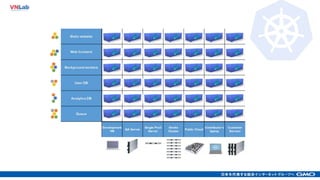



















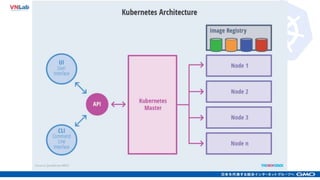










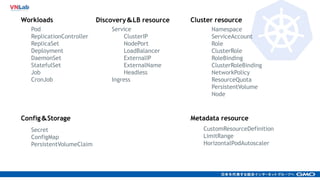









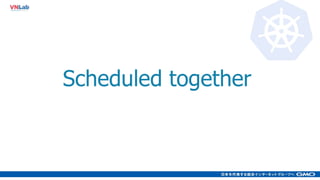










































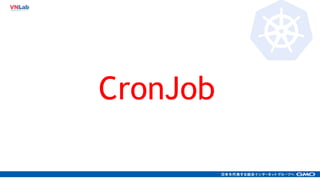






















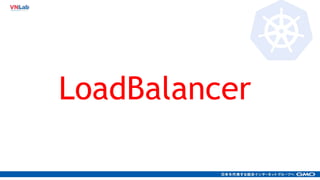

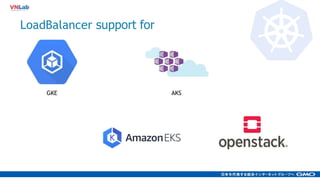

















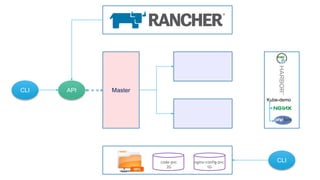





![Đã làm được
Hiểu sâu hơn về kiến trúc dự án GMO POINT hiện tại
Viết blog và chia sẻ
[Nhập môn Kubernetes P1] - Tại sao Kubernetes là cần thiết?
[Nhập môn Kubernetes P2] - Các môi trường Kubernetes
[Nhập môn Kubernetes P3] - Sử dụng Rancher 2.0, Cấu trúc môi trường Kubernetes
[Nhập môn Kubernetes P4] - Nền tảng Kubernetes
[Nhập môn Kubernetes P5] - Kubernetes Workloads Resource (1)
[Nhập môn Kubernetes P6] - Kubernetes Workloads Resource (2)
[Nhập môn Kubernetes P9] - Kubernetes Config&Storage Resource (1)
[Nhập môn Kubernetes P11] - Quản lý Container Images bảo mật với Harbor](https://image.slidesharecdn.com/kubernetesphongnx-180924005904/85/Tim-hi-u-va-tri-n-khai-ng-d-ng-Web-v-i-Kubernetes-145-320.jpg)



































![[DevDay2019] Develop a web application with Kubernetes - By Nguyen Xuan Phong...](https://cdn.slidesharecdn.com/ss_thumbnails/phongnguyen-kubernetesphongnxdevday-190408091447-thumbnail.jpg?width=560&fit=bounds)





































